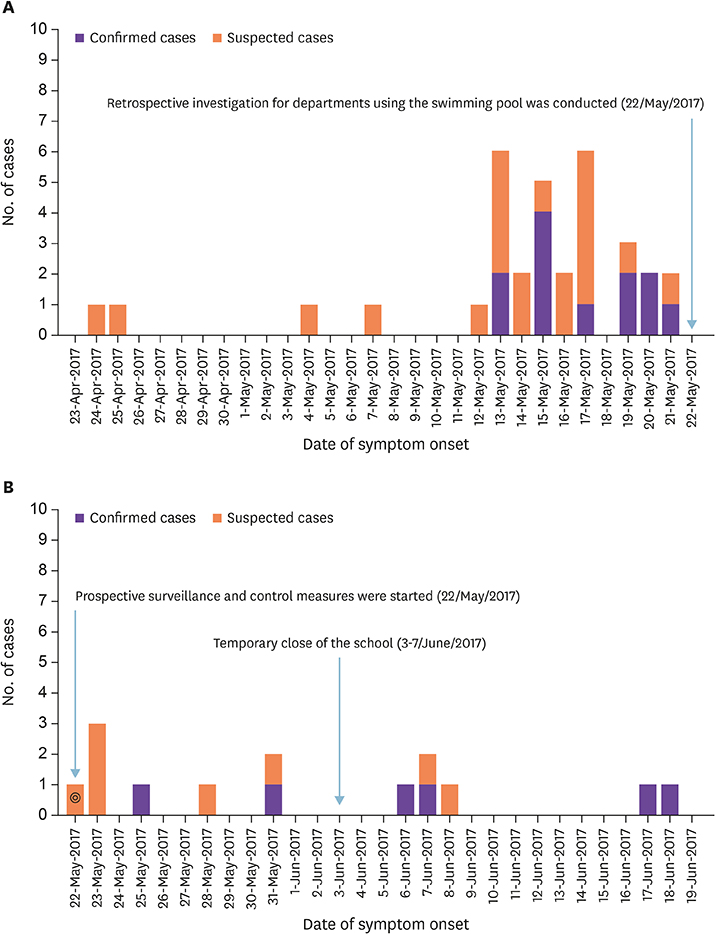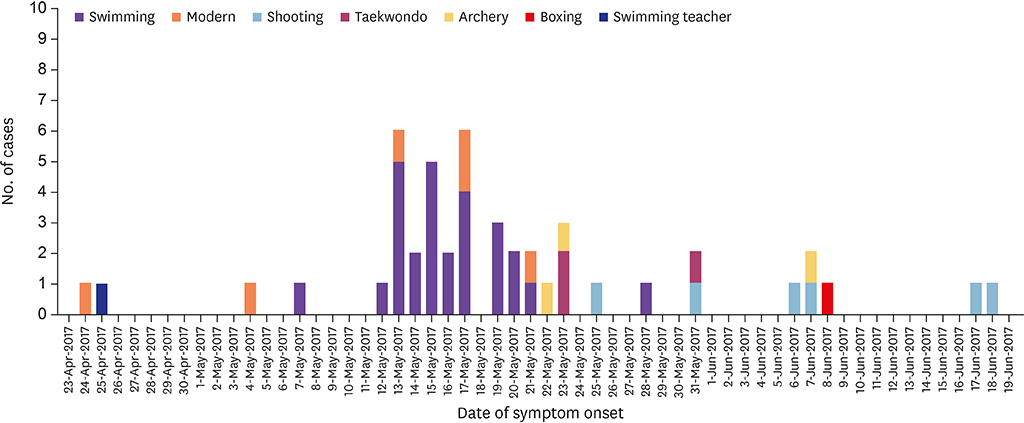Infect Chemother.
2019 Jun;51(2):119-129. 10.3947/ic.2019.51.2.119.
Epidemiological Investigation of the Outbreak of Acute Respiratory Infection caused by Adenovirus Type B55 in a Physical Education School in 2017
- Affiliations
-
- 1Division of Infectious Disease Control, Korea Centers for Disease control and Prevention, Cheongju, Korea.
- 2Division of Control for Zoonotic and vector borne Disease, Korea Centers for Disease control and Prevention, Cheongju, Korea. cho6404@korea.kr
- KMID: 2450868
- DOI: http://doi.org/10.3947/ic.2019.51.2.119
Abstract
- BACKGROUND
On May 19, 2017, the cluster of 6 acute respiratory infections due to adenovirus in the swimming department of a physical education school (School J) was reported to Korea Centers for Disease Control and Prevention. An epidemiological investigation was conducted to identify the transmission route of the infection and to control the outbreak.
MATERIALS AND METHODS
A retrospective cohort study (Study 1) was conducted on students and teachers of the athletic departments using the swimming pool, and a prospective surveillance (Study 2) was conducted on all students and teachers of the School J. A case was defined as any student and school personnel who developed more than two of the following symptoms from April 10 to July 2, 2017: fever, sore throat, cough, rhinorrhea, or headache. Relative risks (RRs) were calculated to compare the attack rates according to potential risk factors. Multivariable logistic regression was performed to identify the risk factors for infection in the outbreak.
RESULTS
47 cases were identified: 33 (55.9%) cases occurred among 59 students and teachers in Study 1 and 14 (3.9%) among 362 students and school personnel in Study 2. There were 18 laboratory confirmed adenovirus infection cases. The common symptoms were headache (71.7%), fever (69.6%), rhinorrhea (63.0%), sputum (56.5%), and sore throat (54.3%). 23.9% of the cases were accompanied with diarrhea and 19.6% with eye congestion. None of the cases developed pneumonia. 32.6% of the cases were hospitalized. In Study 1, attack rate in the swimming department was higher than that in others (RR: 1.90; 95% confidence interval [CI]: 1.01-3.60). In Study 2, being a member of the shooting department (RR: 20.70; 95% CI: 4.90-87.47) and being a first year high school student (RR: 10.95; 95% CI: 2.90-41.33) were identified as risk factors for the infections. Genetic analyses of the adenoviruses showed 100% identical sequence in homology and confirmed the human adenovirus B55 (HAdV-B55). No adenovirus was detected at examining the water and environment of the swimming pool and dormitory.
CONCLUSION
The outbreak is inferred to be occurred via propagated transmission among the students in the same athletic department, while the students with symptoms of respiratory infection continued performing school activities without any restrictions. Infection control measures such as early detection of symptoms of respiratory infection and restriction of group activity are necessary to prevent respiratory infection outbreak in the communal living setting.
MeSH Terms
-
Adenoviridae Infections
Adenoviridae*
Adenoviruses, Human
Centers for Disease Control and Prevention (U.S.)
Cohort Studies
Cough
Diarrhea
Estrogens, Conjugated (USP)
Fever
Headache
Humans
Infection Control
Korea
Logistic Models
Pharyngitis
Physical Education and Training*
Pneumonia
Prospective Studies
Respiratory Tract Infections
Retrospective Studies
Risk Factors
Sports
Sputum
Swimming
Swimming Pools
Water
Estrogens, Conjugated (USP)
Water
Figure
Reference
-
1. Hage E, Gerd Liebert U, Bergs S, Ganzenmueller T, Heim A. Human mastadenovirus type 70: a novel, multiple recombinant species D mastadenovirus isolated from diarrhoeal faeces of a haematopoietic stem cell transplantation recipient. J Gen Virol. 2015; 96:2734–2742.
Article2. Korean Centers for Disease Control and Prevention (KCDC). Guidelines for control of acute respiratory infection. Osong: KCDC;2018.3. Kim YK. Respiratory virus. Korean Society of Infectious Diseases (KSID). Infectious disease. Revised ed. Seoul: Koonja;2014. p. 817–830.4. Li X, Kong M, Su X, Zou M, Guo L, Dong X, Li L, Gu Q. An outbreak of acute respiratory disease in China caused by human adenovirus type B55 in a physical training facility. Int J Infect Dis. 2014; 28:117–122.
Article5. Yi L, Zou L, Lu J, Kang M, Song Y, Su J, Zhang X, Liang L, Ni H, Ke C, Wu J. A cluster of adenovirus type B55 infection in a neurosurgical inpatient department of a general hospital in Guangdong, China. Influenza Other Respi Viruses. 2017; 11:328–336.
Article6. Centers for Disease Control and Prevention (CDC). Acute respiratory disease associated with adenovirus serotype 14--four states, 2006-2007. MMWR Morb Mortal Wkly Rep. 2007; 56:1181–1184.7. Scott MK, Chommanard C, Lu X, Appelgate D, Grenz L, Schneider E, Gerber SI, Erdman DD, Thomas A. Human adenovirus associated with severe respiratory infection, Oregon, USA, 2013-2014. Emerg Infect Dis. 2016; 22:1044–1051.
Article8. Kajon AE, Lamson DM, Bair CR, Lu X, Landry ML, Menegus M, Erdman DD, St George K. Adenovirus type 4 respiratory infections among civilian adults, Northeastern United States, 2011-2015. Emerg Infect Dis. 2018; 24:201–209.
Article9. Lebeck MG, McCarthy TA, Capuano AW, Schnurr DP, Landry ML, Setterquist SF, Heil GL, Kilic S, Gray GC. Emergent US adenovirus 3 strains associated with an epidemic and serious disease. J Clin Virol. 2009; 46:331–336.
Article10. Center for Disease Control and Prevention (CDC). Adenovirus. Accessed 7 January 2019. Available at: http://www.cdc.gov/adenovirus/about/transmission.html.11. D'Angelo LJ, Hierholzer JC, Keenlyside RA, Anderson LJ, Martone WJ. Pharyngoconjunctival fever caused by adenovirus type 4: report of a swimming pool-related outbreak with recovery of virus from pool water. J Infect Dis. 1979; 140:42–47.12. Wei SH. An adenovirus outbreak associated with a swimming facility. SM Trop Med J. 2006; 1:1007–1009.
Article13. Sanchez JL, Binn LN, Innis BL, Reynolds RD, Lee T, Mitchell-Raymundo F, Craig SC, Marquez JP, Shepherd GA, Polyak CS, Conolly J, Kohlhase KF. Epidemic of adenovirus-induced respiratory illness among US military recruits: epidemiologic and immunologic risk factors in healthy, young adults. J Med Virol. 2001; 65:710–718.
Article14. Foy HM, Cooney MK, Hatlen JB. Adenovirus type 3 epidemic associated with intermittent chlorination of a swimming pool. Arch Environ Health. 1968; 17:795–802.
Article15. Kolavic-Gray SA, Binn LN, Sanchez JL, Cersovsky SB, Polyak CS, Mitchell-Raymundo F, Asher LV, Vaughn DW, Feighner BH, Innis BL. Large epidemic of adenovirus type 4 infection among military trainees: epidemiological, clinical, and laboratory studies. Clin Infect Dis. 2002; 35:808–818.
Article16. Radin JM, Hawksworth AW, Blair PJ, Faix DJ, Raman R, Russell KL, Gray GC. Dramatic decline of respiratory illness among US military recruits after the renewed use of adenovirus vaccines. Clin Infect Dis. 2014; 59:962–968.
Article17. Heo JY, Kim HK, Cha YJ, Lee JE, Shim YS, Choe KW. A clinical features of severe adenovirus pneumonia among members of the Korea military: A case series. Infect Chemother. 2012; 44:372–376.
Article18. Yoon JG, Lee SN, Lee JM, Noh JY, Song JY, Cheong HJ, Kim WJ. Pneumonia caused by adenovirus genotype 55 in an army recruit training center. Korean J Med. 2016; 90:365–368.
Article19. Yoon H, Jhun BW, Kim H, Yoo H, Park SB. Characteristics of adenovirus pneumonia in Korean military personnel, 2012-2016. J Korean Med Sci. 2017; 32:287–295.
Article20. Yoo H, Gu SH, Jung J, Song DH, Yoon C, Hong DJ, Lee EY, Seog W, Hwang IU, Lee D, Jeong ST, Huh K. Febrile respiratory illness associated with human adenovirus type 55 in South Korea Military, 2014-2016. Emerg Infect Dis. 2017; 23:1016–1020.
Article21. Rozwadowski F, Caulcrick-Grimes M, McHugh L, Haldeman A, Fulton T, Killerby M, Schneider E, Lu X, Sakthivel SK, Bhatnagar J, Rabeneck DB, Zaki S, Watson J. Notes from the field: fatalities associated with human adenovirus type 7 at a substance abuse rehabilitation facility - New Jersey, 2017. MMWR Morb Mortal Wkly Rep. 2018; 67:371–372.
Article22. Koren MA, Arnold JC, Fairchok MP, Lalani T, Danaher PJ, Schofield CM, Rajnik M, Hansen EA, Mor D, Chen WJ, Ridoré M, Burgess TH, Millar EV. Type-specific clinical characteristics of adenovirus-associated influenza-like illness at five US military medical centers, 2009-2014. Influenza Other Respir Viruses. 2016; 10:414–420.
Article23. Walsh MP, Seto J, Jones MS, Chodosh J, Xu W, Seto D. Computational analysis identifies human adenovirus type 55 as a re-emergent acute respiratory disease pathogen. J Clin Microbiol. 2010; 48:991–993.
Article24. Salama M, Amitai Z, Amir N, Gottesman-Yekutieli T, Sherbany H, Drori Y, Mendelson E, Carmeli Y, Mandelboim M. Outbreak of adenovirus type 55 infection in Israel. J Clin Virol. 2016; 78:31–35.
Article
- Full Text Links
- Actions
-
Cited
- CITED
-
- Close
- Share
- Similar articles
-
- Epidemiology and Characteristics of Pediatric Respiratory Virus Infection From 2017 to 2019 Focusing on Human Coronavirus: A Retrospective Study of a Single Center in Northwestern Gyeonggi-do
- An Epidemiological Study of Acute Viral Lower Respiratory Tract Infections in Hospitalized Children from 1996 to 2002 in Seoul, Korea
- The Changes in Respiratory and Enteric Adenovirus Epidemiology in Korea From 2017 to June 2022
- Adenoviral Lower Respiratory Tract Infection of Children in Korea from 1990 Through 1998
- Clinical and Epidemiological Characteristics of Coronavirus Disease 2019 in the Early Stage of Outbreak



